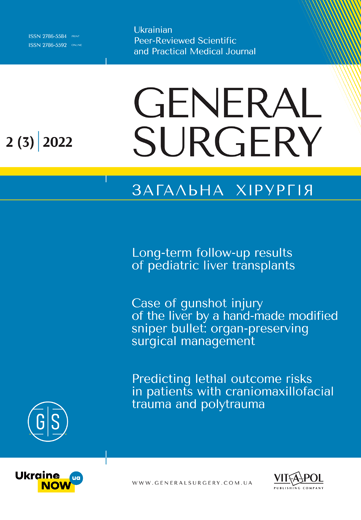Case of gunshot injury to the liver by a hand-made modified sniper bullet: organ-preserving surgical management with damage control tactics and transpapillary biliary decompression
DOI:
https://doi.org/10.30978/GS-2022-2-64Keywords:
liver injury, biliary decompression, multiple projectile wounds, thoracoabdominal injury, damage control tactics, stent occlusion, war in Ukraine, hybrid warfareAbstract
Combat penetrating gunshot injuries are frequently associated with damage to the liver. A bile leak and an external biliary fistula (EBF) are typical complications. Biliary decompression is commonly applied for the management of EBF. Furthermore, there is insufficient data available regarding the characteristics of combat trauma and its management in the context of ongoing hybrid warfare in East Ukraine.
A 23yearold male was admitted with a thoracoabdominal penetrating gunshot wound (GSW) that was caused by a highenergy multiple metal projectile (a fragmented sniper bullet). Damage control tactics was applied at all 4 levels of military medical care. Endoscopic retrograde cholangiopancreatography (ERCP), endoscopic sphincterotomy, and placement of a biliary stent were used for evaluation and biliary decompression. Stent occlusion was treated with stent replacement and scheduled ERCP. Partial EBF was diagnosed based on the primary wound defect of the liver and was closed without surgical intervention on the 34th day after injury. Acute cholecystitis was associated with ERCP and was managed with cholecystostomy.
The combination of operative and nonoperative techniques for the management of the combat GSW to the liver is effective, along with the application of damage control tactics. Scheduled ERCP is effective for the management of EBF, so liver resection can be avoided. The transpapillary intervention with stent placement was successfully used for biliary decompression. Early posttraumatic stent occlusion can be diagnosed and effectively managed by scheduled ERCP as well as stent replacement with a largediameter stent inserted as close as possible to the site of bile leak.
Downloads
Published
How to Cite
Issue
Section
License
Copyright (c) 2022 Authors

This work is licensed under a Creative Commons Attribution-NoDerivatives 4.0 International License.






